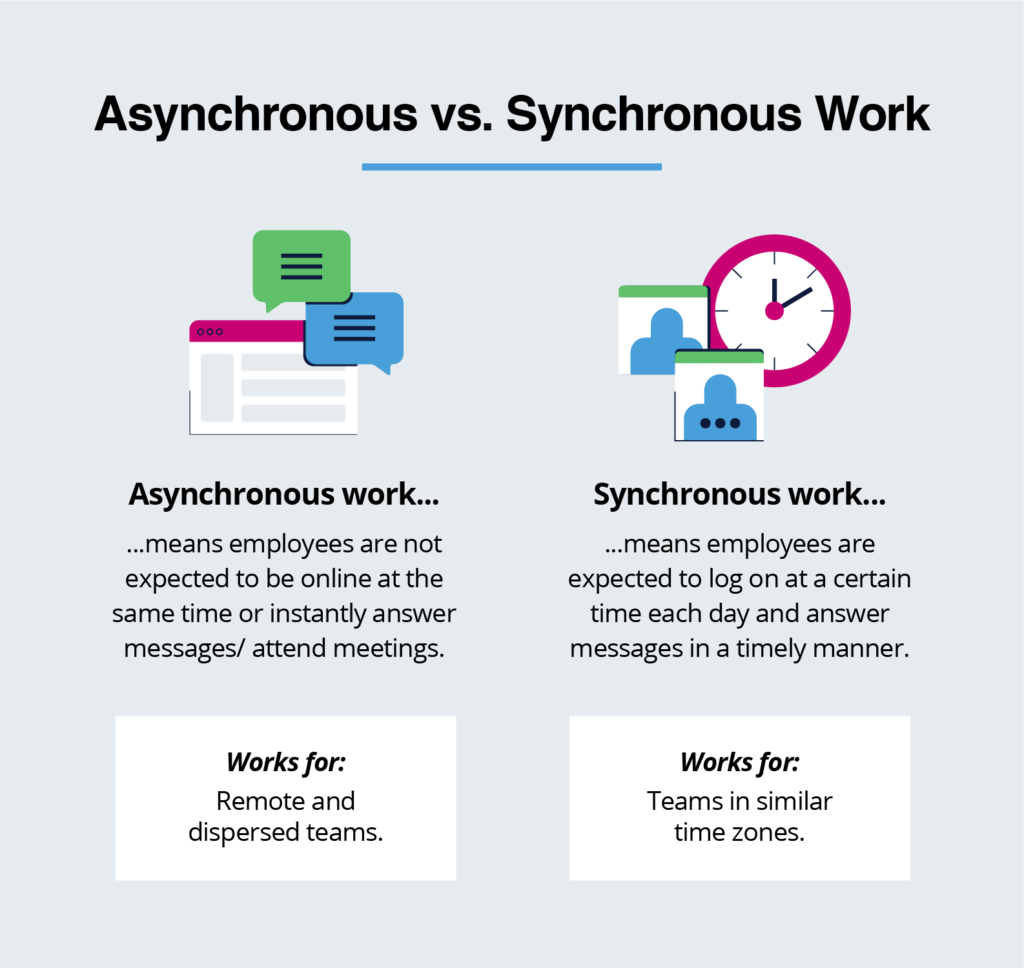Asynchronous work is when a company’s roster isn’t expected to be online at the same time or complete their work simultaneously. This working model works for remote, dispersed teams who work in different time zones or have a flexible working arrangement.
Under this model, employees can work independently and won’t be expected to answer messages instantly or be online at certain times. With the increasing popularity of remote work and adaptability of employee rosters, many companies are opting for asynchronous working models to give their employees more flexibility while also opening their company up to the global talent pool. When your company works asynchronously, you’re able to hire people living and working in different time zones.
But like any organizational structure, asynchronous work will only benefit your company if you communicate clearly and plan ahead. We’ve put together a guide to async work for business leaders.
Key Takeaways:
- Asynchronous working is a work model often employed by remote teams that doesn’t require team members to be logged on at the same time
- Async work models can help offices go global and hire employees from around the world
- Successful asynchronous working requires transparency, communication, and documentation
Asynchronous vs. Synchronous Work

Simply put: Asynchronous work is when employees do not have to be logged on at the same time and aren’t expected to answer messages immediately. Synchronous work, on the other hand, is when employees work a typical schedule (usually 9 a.m. to 5 p.m. or 10 a.m. to 6 p.m.) and are expected to respond to messages in a timely manner.
Examples of asynchronous work:
- Employees work independently on their own projects
- Employees can answer chat or email messages when it’s convenient for them to do so
- Employees usually won’t have to log into meetings or attend live sessions of any kind
Examples of synchronous work:
- Employees are usually expected to start working between the hours of 9 a.m. and 10 a.m. in one specific time zone
- Employees are expected to answer chat messages or emails within the hour they are received
- Employees will have to log into virtual meetings or attend in-person meetings with their team at a specific time
Benefits of Asynchronous Work
Asynchronous work can be hugely beneficial to both employees and managers. It allows employees to be more flexible while allowing managers to hire from the vast global talent pool.
1. Prioritizes Employee Independence
Under asynchronous work models, employees are able to be independent and flexible. They’re able to work at times when they’ll be most productive and complete their work on their own terms. For many employees, this leads to increased happiness and even increased productivity — a staggering number of employees reported flexibility and independence as the biggest benefits of working from home.
2. Allows You to Hire Globally Without Hurdles
Let’s say you own a tech company in San Francisco, California. If your employees report to work at 9 a.m. and you want to hire globally, it would be 2 a.m. the next day for potential employees in Tokyo, Japan.
Async work can take care of that hurdle. By letting employees across the globe work during their typical work hours, you’ll be able to reap the many benefits of global employees without pushing them to work out of working hours.
3. Enhances Team Productivity
Asynchronous work often means that companies have to be diligent about documenting conversations and workflow changes, and all of these materials must be easily accessible to every employee.
This can mean that employees don’t have to wait for updates from team members to complete their work and can get their tasks done quicker. Async teams are able to move through the project cycle faster which can mean they’re altogether more productive.
6 Tips For Managing Asynchronous Teams
Working asynchronously comes with many benefits — but it requires work to get there. Business leaders should be communicative and thorough to set their teams up for success.
1. Add Buffers Into Your Scheduling

When your team is dispersed, some employees might be located in places that are anywhere from eight to 12 hours ahead or behind your time zone. And as business can be unpredictable, it’s best to allow some wiggle room in case employees have something come up and can’t contact you to let you know a project will be delayed.
Add one or two-day buffers in your schedules to account for any missed deadlines and keep projects running smoothly.
Tip: Don’t schedule two steps of your project cycle in the same day, especially if they are completed by two different people.
2. Schedule Meetings Only When Necessary
One of the main benefits of asynchronous work is that employees are able to work fully independently. So, logging onto a meeting at a specific time is a hindrance to their productivity and ability to work. For some, logging onto a meeting may also mean getting on the computer late in the evening (remember: It’s 7 p.m. in London, England, when it’s 11 a.m. in San Francisco, California!).
Though some meetings will be necessary, try to avoid them and only schedule meetings when it is crucial.
Tip: Big, company-wide announcements, training or lessons, disciplinary meetings, or town halls to get employee feedback may constitute necessary meetings.
3. Leverage Technology
Asynchronous work goes hand in hand with remote work. And like remote work, async teams rely on technology. Technology allows dispersed teams to communicate, manage projects, document their work, and access any relevant project or training materials.
Tip: Shared calendars and/or project management databases can help your team keep track of their coworkers’ schedules.
4. Communicate Efficiently and Specifically
Async teams don’t have time for the so-called “water cooler conversations.” Communication between dispersed teams should be clear and efficient, so each party knows their exact next steps and can plan accordingly.
As communication may not be immediate or simultaneous, you should work to make sure each person you’re communicating with will know exactly what you need and why you’re asking.
Tip: Find a balance between being friendly and informative. Just because your communication should be direct and succinct doesn’t mean you can’t imbue your personality and get to know your team.
5. Organize Your Workspace
When your team won’t be online simultaneously, everyone should still know exactly where they need to go to find the tools or answers they need. That means your digital workspace should be clutter-free and easy to navigate. Have your training materials, project management information, and any other workplace tools clearly labeled and easily accessible.
Tip: The goal of an organized workspace is to reduce employees’ reliance on other people to get the information they need. Organize your files and training materials by subject, job position, and relevance.
6. Optimize Your Onboarding
Onboarding is a critical time for new hires to become familiar with their workload and confident in their ability to execute it. For async teams who may not get tons of face time with management, it is especially important that these employees are given the training and tools they need to succeed.
Tip: A mentorship system where a new employee is paired with an experienced one who will be working similar hours can give new hires someone to reach out to with questions.
How To Communicate Asynchronously
Asynchronous communication can be a challenge. Communicating asynchronously means you might send an email or message that won’t get answered until hours or even days later. However, technology allows teams throughout the globe to stay connected and productive.
A few of the tools available for async communication include:
- Messaging platforms like Slack or Google Chat
- Project management platforms like Basecamp or Asana
- Scheduling tools like Smartsheet or Trello
As a best practice, anything that needs a paper trail or involves multiple people should be discussed on public threads like a Slack channel or project management database. Check-ins or more informal communication can be left to private messages or emails.
Tips to Improve Async Communication
Asynchronous communication shouldn’t leave any of your employees feeling like an afterthought. A few ways to make sure your communication is strong include:
- Treat all timezones equally. Rotate the times of your synced meetings to make them convenient for all time zones on a rolling basis and show your team that you’re not giving any one group preferential treatment.
- Streamline your processes. Employees can run into headaches if the project they’re working on is splintered between communication channels. Set clear guidelines for how to communicate about a project and where to submit work.
- Be mindful with your pings. Learn to differentiate between urgent and non-urgent communication. Consistently messaging your team with demands or questions can up their anxiety. Instead, be thoughtful and intentional with your messaging.
Stay In Sync: When Is Asynchronous Communication Not the Right Option?
When leaning into async work, you should develop a remote-first mindset. That means that, for the most part, you won’t be meeting face-to-face with your team. However, there are still some situations in which synchronous communication will be the right way to go.
You should sync up for a chat when:
- You’re hiring or firing someone
- You’re hosting a team-building event or casual hangout
- You have a big announcement like a notable person leaving, company-wide change, or other structural shake-up
- You’re going to discuss an emotionally charged or sensitive topic with an employee, like a personal, medical, or familial emergency
- You’re conducting a one-on-one meeting or check-in
Keep Up With Your Team
Asynchronous, global teams can bring a lot of value to any company — that is, if you know how to handle it. In the event you’re looking to expand overseas and cultivate a dispersed workforce, let a globalization partnerlike Velocity Global handle your logistics.
Reach out to us today to see how we can help.




